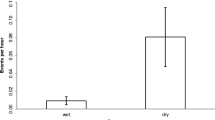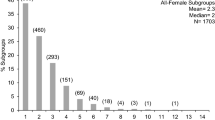Abstract
Relatively little information is available regarding the role of social grooming and embraces in spider monkeys that live in fission-fusion societies in which individuals are usually split into subgroups. We investigated whether embraces and grooming have similar roles in captive spider monkeys by examining their occurrence in two contexts. One context was fusion, i.e. when the monkeys moved into an area of the enclosure where other monkeys were present, in which individuals from different subgroups were expected to exchange greeting behavior. The other context was the access to young infants, in which females were expected increase their friendly behavior toward mothers. We collected data by observing all individuals within a subgroup and via focal animal sampling. We found that overall embraces occurred more frequently than grooming and that their distributions were not correlated. The frequency of embraces was positively associated with the number of fusion events per observation, whereas the frequency of grooming bouts was not. Furthermore, embraces were more frequent following initial approaches after fusion versus subsequent approaches, and the figure was higher than the corresponding one for grooming. Mothers received more embraces after than before the birth of their infants, whereas there was no such effect for grooming. Embraces, but not grooming, play a role in the regulation of social relationships in spider monkeys. Embraces may serve as signals of benign disposition in contexts that are likely to be associated with tension, such as fusion and access to infants.
Similar content being viewed by others
References
Ahumada, J. A. (1992). Groooming behavior of the spider monkeys (Ateles geoffroyi) on Barro Colorado Island, Panama. Int. J. Primatol. 13: 33–49.
Altmann, J. (1974). Observational study of behavior: Sampling methods. Behaviour 49: 227–267.
Aureli, F., Preston, S. D., and de Waal, F. B. M. (1999). Heart rate responses to sical interactions in free-moving rhesus macaques: A pilot study. J. Comp. Psych. 113: 59–65.
Aureli, F., Cords, M., and van Schaik, C. P. (2002). Conflict resolution following aggression in gregarious animals: A predictive framework. Anim. Behav. 64: 325–343.
Barrett, L., Gaynor, D., and Henzi, S. P. (2002). A dynamic interaction between aggression and grooming reciprocity among female chacma baboons. Anim. Behav. 63: 1047–1053.
Bauer, H. R. (1979). Agonistic and grooming behavior in the reunion context of Gombe Stream chimpanzees. In Hamburg D. A. and McCown E. R. (eds.), The Great Apes, The Benjamin/Cummings Publishing Company Menlo Park, CA, pp. 395–404.
Chapman, C. A. (1990). Association patterns of spider monkeys: The influence of ecology and sex on social organization. Behav. Ecol. Sociobiol. 26: 409–414.
Colmenares, F. (1990). Greeting behaviour in male baboons, I: Communication, reciprocity and symmetry. Behaviour 113: 81–116.
Comenares, F. (1991). Greeting behaviour between male baboons: Oestrous females, rivalry and negotiation. Anim. Behav. 41: 49–60.
Colmenares, F., Hofer, H., and East, M. L. (2000). Greeting ceremonies in baboons and hyenas. In: Aureli, F., and de Waal, F. B. M. (eds.), Natural Conflict Resolution, University of California Press, Berkeley, pp. 94–96.
Davis, N., Schaffner, C. M., and Smith, T. E. (2005). Evidence that zoo visitors influence HPA activity in spider monkeys (Ateles geoffroyi). App. Anim. Behav. Sci. 90(2): 131–141.
de Waal, F. B. M. (1987). Tension regulation and nonreproductive functions of sex in captive bonobos (Pan paniscus). Natl. Geogr. Res. 3: 318–335.
de Waal, F. B. M. (1989). Food sharing and reciprocal obligations among chimpanzees. J. Hum. Evol. 18: 433–459.
de Waal, F. B. M., and Luttrell, L. M. (1989). Toward a comparative socioecology of the genus Macaca: Different dominance styles in rhesus and stumptail macaques. Am. J. Primatol. 19: 83–109.
Di Bitetti, M. S. (1997). Evidence for an important social role of allogrooming in a platyrrhine primate. Anim. Behav. 54: 199–211.
Dunbar, R. I. M. (1988). Primate Social Systems. Cornell University Press, Ithaca.
East, M. L., Hofer, G., and Wickler, W. (1993). The erect ‘penis’ is a flag of submission in a female-dominated society: Greetings in Serengeti spotted hyenas. Behav. Ecol. Sociobiol. 33: 355–370.
Eisenberg, J. F. (1976). Communication mechanisms and social integration in the black spider monkey, Ateles fusciceps robustus, and related species. Smithson. Contrib. Zool. 213: 1–108.
Eisenberg, J. F., and Kuehn, R. E. (1966). The behaviour of Ateles geoffroyi and related species. Smithson. Misc. Coll. 151: 1–63.
Evans, S., and Poole, T. B. (1984). Long-term changes and maintenance of the pairbond in common marmosets, Callithrix jacchus jacchus. Folia primatol. 42: 33–41.
Fairbanks, L. (1980). Relationships among adult females in captive vervet monkeys: Testing a model of rank-related attractiveness. Anim. Behav. 28: 853–859.
Goodall, J. (1986). The Chimpanzees of Gombe, Harvard University Press, Cambridge, MA.
Hemelrijk, C. K. (1994). Support ofr being groomed in long-tailed macaques, Macaca fascicularis. Anim. Behav. 48: 479–481.
Henzi, S. P., and Barrett, L. (2002). Infants as a commodity in a baboon market. Anim. Behav. 63: 915–921.
Hohmann, G., and Fruth, B. (2000). Use and function of gential contacts among female bonobos. Anim. Behav. 60: 107–120.
Hutchins, M., and Barash, D. P. (1976). Grooming in primates: Implications for its utilitarian functions. Primates 17: 145–150.
Jones, C. B. (1979). Grooming in the mantled howler monkey, Alouatta palliata Gray. Primates 20: 289–292.
Kano, T. (1989). The sexual behavior of pygmy chimpanzees. In: Heltne, P. G., and Marquardt, L. E. (eds.), Understanding Chimpanzees, Harvard University Press, Cambridge, MA, pp. 176–183.
Kapsalis, E., and Berman, C. M. (1996). Models of affiliative relationships among free-ranging rhesus monkeys (Macaca mulatta)L II. Testing predictions for three hypothesized organizing principles. Behaviour 133: 1235–1263.
Keverne, E. B., Martensz, N. D., and Tuite, B. (1989). Beta-endorphin concentrations in cerebrospinal fluid of monkeys are influenced by grooming relationships. Psychoneuroendocrino. 14: 155–161.
Klein, L., and Klein, D. (1971). Aspects of social behaviour in a colony of spider monkeys Ateles geoffroyi at San Francisco Zoo. Int. Zoo Yrbk. 22: 175–181.
Kruuk, H. (1972). The spotted hyaena, Chicago, University of Chicago Press.
Lancaster, J. (1971). Play-mothering: The relationship between juvenile females and young infants among free-ranging vervet monkeys (Cercopithecus aethiops) Folia Primatol. 15: 161–182.
Leca, J. B., Fornasieri, I., and Petit, O. (2002). Aggression and reconciliation in Cebus capucinus. Int. J. Primatol. 23: 979–998.
Manson, J., Perry, S., and Parish, A. R. (1997). Nonconceptive sexual behavior in bonoobos and capuchins. Int. J. Primatol. 18: 767–786.
McFarland Symington, M. (1990). Fission-fusion social organization in Ateles and Pan. Int. J. Primatol. 11: 47–61.
Maestripieri, D. (1994). Influence of infants on female social relationships in monkeys. Folia primatol. 63:192–202.
Nishida, T., Kano, T., Goodall, J., McGrew, W. C., and Nakumura, M. (1999). Ethogram and ethnography of Mahale chimpanzees. Anthropol. Sci. 107: 141–188.
O'Brien, T. G. (1993). Allgrooming behaviour among adult female wedge-capped capuchin monkeys. Anim. Behav. 46: 499–510.
Okamoto, K., Agetsuma, N., and Kojima, S. (2001). Greeting behavior during party encounters in captive chimpanzees. Primates 42: 161–165.
Parish, A. R. (1994). Sex and food control in the “uncommon chimpanzee”: How bonobo females overcome a phylogenetic legacy of male dominance. Ethol. Sociobiol. 15: 157–179.
Parr, L. A., Matheson, M. D., Bernstein, I. S., and de Waal, F. B. M. (1997). Grooming down the hierarchy: Allogrooming in captive brown capuchin monkeys, Cebus apella. Anim. Behav. 54: 361–367.
Pastor-Nieto, R. (2001). Grooming, kinship and co-feeding in captive spider monkeys (Ateles geoffroyi). Zoo Biol. 20: 293–303.
Pereira, M. E., Schill, J. L., and Charles, E. P. (2000) Reconciliation in captive Guyanese squirrel monkeys (Saimiri sciureus). Am. J. Primatol. 50: 159–167.
Perry, S. (1996). Female-female social relationships in wild white-faced capuchin monkeys, Cebus capucinus. Am. J. Primatol. 40: 167–182.
Rondinelli, R., and Klein, L. L. (1976). An anlysis of adult social spacing tendencies and related social interactions in a colony of spider monkeys (Ateles geoffroyi) at the San Francisco Zoo. Folia primatol. 25: 122–142.
Rylands, A. B., Schneider, H., Langguth, Mittermeier, R. A., Groves, C. P., and Rodriguez-Luna, E. (2000). An assessment of the diversity of New World primates. Neotrop. Primates 8: 61–93.
Schaffner, C. M., Shepherd, R. E., Santos, C. V., and French, J. A. (1995). Development of heterosexual relationships in Wied's black tufted-ear marmosets (Callithrix kuhli). Am. J. Primatol. 36: 185–200.
Schaffner, C. M., Verpooten, J., and Aureli, F. (2003). The behavioral consequences of fusion in a wild group of spider monkeys. Am. J. Primatol. Supp. 60(1): 140–141.
Schino, G. (2001). Grooming, competition and social rank among female primates: A meta—analysis. Anim. Behav. 62: 265–271.
Schino, G., Schucchi, S., Maestripieri, D., and Turillazzi, P. G. (1988). Allogrooming as a tension-reduction mechanisms: A behavioural approach. Am. J. Primatol. 16: 43–50.
Seyfarth, R. M. (1977). A model of social grooming among adult female monkeys. J. Theor. Biol. 65: 671–698.
Seyfarth, R. M. (1980). The distribution of grooming and related behaviours among adult female vervet monkeys. Anim. Behav. 28: 798–813.
Silk, J. (1982). Altruism among female Macaca radiata: Explanations and analysis of patterns of grooming and coalition formation. Behaviour 79: 162–188.
Silk, J. (1999). Why are infants so attractive to others? The form and function of infant handling in bonnet macaques. Anim. Behav. 57: 1021–1032.
Silk, J. B. (2002). The form and function of reconciliation in primates. Annu. Rev. Anthropol. 31: 21–44.
Silk, J. B, Kaldor, E., and Boyd, R. (2000). Cheap talk when interests conflict. Anim. Behav. 59: 423–432.
Smuts, B. B., and Watanabe, J. M. (1990). Social relationships and ritualized greetings in adult male baboons (Papio cynocephalus anubis). Int. J. Primatol. 11: 147–172.
Stevenson, P. R. (1998). Proximal spacing between individuals in a group of woolly monkeys (Lagothrix lagotricha) in Tingue National Park, Colombia. Int. J. Primatol. 19: 299–311.
Strier, K. B., Dib, L. T., and Figueira, J. E. C. (2002). Social dynamics of male muriquis (Brachyteles arachnoids hypoxanthus). Behav. 139: 315–342.
Teixidor, P., and Byrne, R. W. (1999). The ‘whinny’ of spider monkeys: Individual recognition before situational meaning. Behaviour 136: 279–308.
Terry, R. L. (1970). Primate grooming as a tension reduction mechanism. J. Psychol. 76: 129–136.
Van Roosemalen, M. G. M., and Klein, L. L. (1988). The spider monkeys, genus Ateles. In. Mittermeier, R. A., Rylands, A. B., Coimbra-Filho, A. F., and da Fonseca, G. A. B. (eds.), Ecology and Behavior of Neotropical Primates, World Wildlife Fund, Washington, D.C. pp. 455–537.
Verbeek, P., and de Waal, F. B. M. (1997). Postconflict behavior in captive brown capuchins in the presence and absence of attractive food. Int. J. Primatol. 18: 703–725.
Zahavi, A. (1975). Mate selection: A selection for a handicap. J. Theor. Biol. 53: 205–214.
Zahavi, A., and Zahavi, A. (1997). The handicap principle, Oxford University Press, New York.
Author information
Authors and Affiliations
Corresponding author
Rights and permissions
About this article
Cite this article
Schaffner, C.M., Aureli, F. Embraces and Grooming in Captive Spider Monkeys. Int J Primatol 26, 1093–1106 (2005). https://doi.org/10.1007/s10764-005-6460-6
Received:
Revised:
Accepted:
Issue Date:
DOI: https://doi.org/10.1007/s10764-005-6460-6




